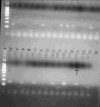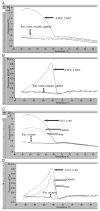Real-time polymerase chain reaction for the rapid detection of group B streptococcal colonization in neonates
- PMID: 16818544
- PMCID: PMC1513630
- DOI: 10.1542/peds.2005-1594
Real-time polymerase chain reaction for the rapid detection of group B streptococcal colonization in neonates
Abstract
Background: Group B streptococcal (GBS) infection remains a leading cause of neonatal sepsis. Currently, the management guidelines of neonates born to women with unknown GBS status at delivery are unclear. In this cohort, who undergo at least a 48-hour observation, a rapid method of detection of GBS colonization would allow targeted evaluation and treatment, as well as prevent delayed discharge.
Objective: The goal of this research was to evaluate the validity of rapid fluorescent real-time polymerase chain reaction in comparison with standard culture to detect GBS colonization in infants born to women whose GBS status is unknown at delivery.
Design/methods: Neonates at >32 weeks' gestation born to women whose GBS status was unknown at delivery were included. Samples were obtained from the ear, nose, rectum, and gastric aspirate for immediate culture and real-time polymerase chain reaction after DNA extraction using the LightCycler. Melting point curves were generated, and confirmatory agar gel electrophoresis was performed.
Results: The study population (n = 94) had a mean +/- SD gestational age of 38 +/- 2 weeks and birth weight of 3002 +/- 548 g. The rates of GBS colonization by culture were 17% and 51% by real-time polymerase chain reaction. The 4 surface sites had comparable rates of GBS. The overall sensitivities, specificities, and positive and negative predictive values of real-time polymerase chain reaction were: 90%, 80.3%, 28%, and 98.9%.
Conclusions: Real-time polymerase chain reaction resulted in a threefold higher rate of detection of GBS colonization and had an excellent negative predictive value in a cohort of neonates with unknown maternal GBS status at delivery. Thus, real-time polymerase chain reaction would be a useful clinical tool in the management of those infants potentially at risk for invasive GBS infection and would allow earlier discharge for those found to be not at risk.
Figures


References
-
- Schrag SJ, Zywicki S, Farley MM, et al. Group B streptococcal disease in the era of intrapartum antibiotic prophylaxis. N Engl J Med. 2000;342:15–20. - PubMed
-
- Centers for Disease Control and Prevention. Early-onset group B streptococcal disease–United States, 1998 –1999. JAMA. 2000;284:1508–1510. - PubMed
-
- Centers for Disease Control and Prevention. Diminishing racial disparities in early-onset neonatal group B streptococcal disease–United States, 2000–2003. MMWR Morb Mortal Wkly Rep. 2004;53:502–505. - PubMed
-
- ACOG Committee Opinion. Prevention of early-onset group B streptococcal disease in newborns. Obstet Gynecol. 2002;100:1405–1412. - PubMed
-
- Schrag S, Gorwitz R, Fultz-Butts K, Schuchat A. Prevention of perinatal group B streptococcal disease. Revised guidelines from CDC. MMWR Recomm Rep. 2002;51:1–22. - PubMed
Publication types
MeSH terms
Grants and funding
LinkOut - more resources
Full Text Sources
Medical
Molecular Biology Databases

